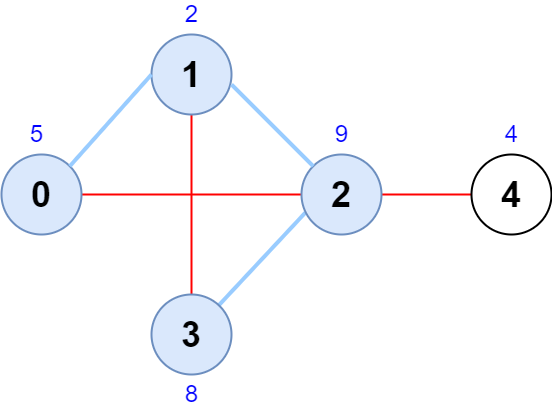Class Solution
- java.lang.Object
-
- g2201_2300.s2242_maximum_score_of_a_node_sequence.Solution
-
public class Solution extends Object
2242 - Maximum Score of a Node Sequence.Hard
There is an undirected graph with
nnodes, numbered from0ton - 1.You are given a 0-indexed integer array
scoresof lengthnwherescores[i]denotes the score of nodei. You are also given a 2D integer arrayedgeswhereedges[i] = [ai, bi]denotes that there exists an undirected edge connecting nodesaiandbi.A node sequence is valid if it meets the following conditions:
- There is an edge connecting every pair of adjacent nodes in the sequence.
- No node appears more than once in the sequence.
The score of a node sequence is defined as the sum of the scores of the nodes in the sequence.
Return the maximum score of a valid node sequence with a length of
4. If no such sequence exists, return-1.Example 1:

Input: scores = [5,2,9,8,4], edges = [[0,1],[1,2],[2,3],[0,2],[1,3],[2,4]]
Output: 24
Explanation: The figure above shows the graph and the chosen node sequence [0,1,2,3].
The score of the node sequence is 5 + 2 + 9 + 8 = 24.
It can be shown that no other node sequence has a score of more than 24.
Note that the sequences [3,1,2,0] and [1,0,2,3] are also valid and have a score of 24.
The sequence [0,3,2,4] is not valid since no edge connects nodes 0 and 3.
Example 2:

Input: scores = [9,20,6,4,11,12], edges = [[0,3],[5,3],[2,4],[1,3]]
Output: -1
Explanation: The figure above shows the graph.
There are no valid node sequences of length 4, so we return -1.
Constraints:
n == scores.length4 <= n <= 5 * 1041 <= scores[i] <= 1080 <= edges.length <= 5 * 104edges[i].length == 20 <= ai, bi <= n - 1ai != bi- There are no duplicate edges.
-
-
Constructor Summary
Constructors Constructor Description Solution()
-
Method Summary
All Methods Instance Methods Concrete Methods Modifier and Type Method Description intmaximumScore(int[] scores, int[][] edges)
-